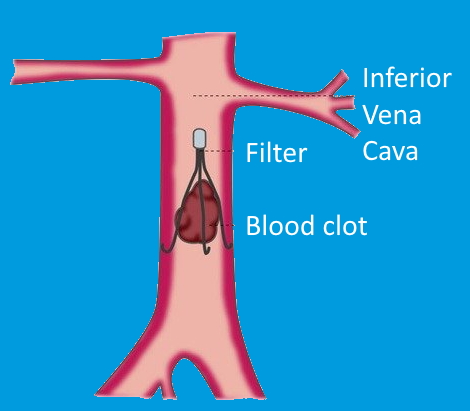IVC Filters
INFERIOR VENA CAVA FILTERS Q & A
What Is an Inferior Vena Cava (IVC) Filter?
Inferior vena cava (IVC) filters are sometimes used in patients with deep vein thrombosis (DVT) or pulmonary embolism (PE). DVT is a condition in which blood clots develop in the legs or pelvis. PE is a serious, and sometimes fatal, condition that occurs when these blood clots break apart, and large pieces travel to the lungs. An IVC filter traps the clot pieces and keeps them from traveling through the vena cava vein, thus protecting the hearts and lungs from the clot fragments. IVC filters do not prevent additional blood clots.
When Are IVC Filters Used?
IVC filters are used when patients cannot be helped by other treatments, such as blood thinning medication. They are generally placed in patients who have developed, or are at risk of developing, blood clots in the legs. These include patients diagnosed with DVT and PE. Trauma victims and people suffering from immobility may also be candidates for IVC filters.
Are There Different Types of IVC Filters?
There are two types of IVC filters. Permanent IVC filters will stay in place indefinitely. Optionally retrievable IVC filters are designed to be removed later, depending on the patient’s continuing blood clot risk. Optionally retrievable IVC filters are often removed within six months, but can also be removed after a few years, or even left in place permanently. Physicians typically determine the best type of IVC filter based on a patient’s risk of additional blood clots and time period of that risk. Another factor is the patient’s ability to take blood thinners.

Frequently Asked Questions
IVC Filter Placement and Removal Patient Education
Inferior Vena Cava (IVC) Filter Placement Q & A
How Is IVC Filter Placement Performed?
Inferior vena cava (IVC) filter placement is a minimally invasive procedure performed under local anesthesia. Only a very small incision is required in the skin. Using image guidance, physicians insert a catheter through the skin into a large vein in the neck or groin. The catheter is guided to the inferior vena cava in the abdomen. Contrast material is injected into the vein to determine proper positioning of the IVC filter. Physicians then place the IVC filter into the vein. Once positioned correctly, the IVC filter will expand to its full size and attach to the blood vessel wall.
What Does IVC Filter Placement Feel Like?
Patients may feel some pressure from the catheter, but there should be minimal discomfort. As the contrast material flows through the veins, patients may also feel some warmth.
Inferior Vena Cava (IVC) Filter Removal Q & A
When Is IVC Filter Removal Required?
Physicians may recommend inferior vena cava (IVC) filter removal when the risk of clots travelling to the lung has passed, or the patient is able to take blood thinners. By removing the filter, any chances of filter complications will be eliminated. However, filter removal does not address the cause of the blood clots, and further treatment may be needed.
How Is IVC Filter Removal Performed?
IVC filter removal is a minimally invasive procedure performed under local anesthesia. First, contrast material is injected into the body. Physicians view the area to determine that there are no blood clots in the path of the filter, and it is safe to continue with the procedure. Using imaging guidance, doctors insert a catheter through the skin into a large vein in the neck or groin. The catheter is then guided to the site of the IVC filter. The IVC filter is then grabbed by the catheter and removed.
What to Expect from IVC Filter Procedures?
Since only a small incision is needed, there are no stitches. Patients will be able to go home the same day as the procedure. Also, recovery time is much shorter than traditional surgery, so daily activities can often be resumed in 24 hours. In terms of IVC placement, IVC filters have a high success rate in preventing PE.
As an interventional radiologist who specializes in vascular disease and management of complex IVC filter cases, Dr. Jilbert Eradat is well-qualified to handle IVC filter placement or removal. At AVI, we use the latest protocols in minimally invasive procedures for managing challenging, high-risk cases in patients who otherwise would have no treatment option.

631 West Avenue Q, Suite A
Palmdale, CA 93551
Phone 661-480-5956
Fax 661-480-5976
Hours
- Monday–Friday
8 am – 5pm
Resources
Connect
